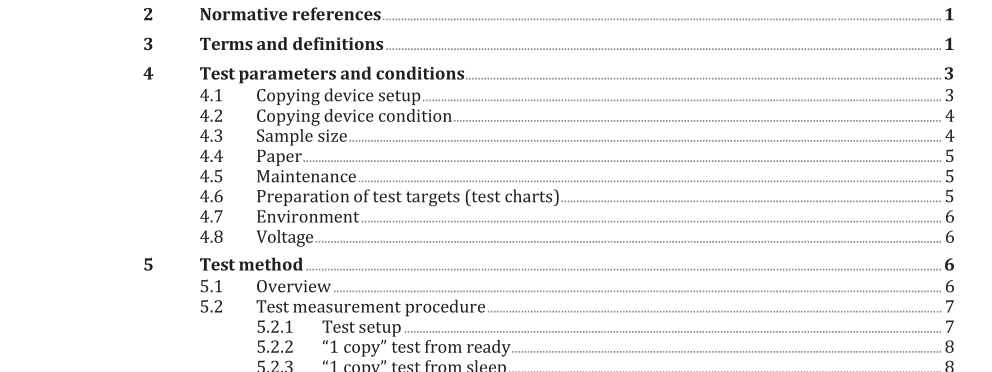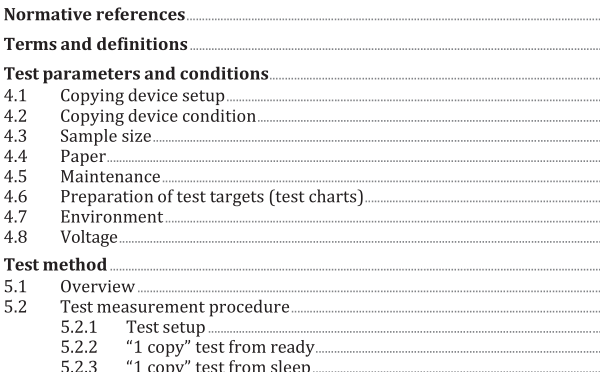ISO IEC 29183:2021 pdf download – Information technology — Office equipment — Method for measuring digital copying productivity for a single one-sided original.
1 Scope This document specifies a method for measuring productivity of digital copying devices and multifunctional devices with various copying modes and a single one-sided original. The document is applicable to digital copying devices and multifunctional devices. The document is intended to be used for black and white (B&W) as well as colour digital copying devices and multifunctional devices of any underlying marking technology. This document includes instructions for the creation of test charts, test setup procedure, test procedure, and the reporting requirements for the digital copying productivity measurements. This document is not intended to replace manufacturer’s rated speeds. 2 Normative references The following documents are referred to in the text in such a way that some or all of their content constitutes requirements of this document. For dated references, only the edition cited applies. For undated references, the latest edition of the referenced document (including any amendments) applies. ISO 536, Paper and board — Determination of grammage ISO 2470-1, Paper, board and pulps — Measurement of diffuse blue reflectance factor — Part 1: Indoor daylight conditions (ISO brightness) ISO/IEC 24734, Information technology — Office equipment — Method for measuring digital printing productivity 3 Terms and definitions For the purposes of this document, the terms and definitions given in ISO/IEC 24734 and the following apply. ISO and IEC maintain terminological databases for use in standardization at the following addresses: — ISO Online browsing platform: available at https://www.iso .org/obp — IEC Electropedia: available at http://www.electropedia .org/ 3.1 sEFTP effective throughput rate at which a device produces pages measured from the initiation of the job through the complete exit of the last test set (3.11) Note 1 to entry: “s ” denotes that a single one sided original is used for the measurement. Note 2 to entry: sEFTP is expressed in images per minute (ipm). sEFTP can be affected by scan time, digital processing time, and maintenance as well as the run time of the test. [SOURCE: ISO/IEC 24734:2021, 3.6, modified — The term “EFTP” has been replaced by “sEFTP” and Note 1 to entry has been added.]
3.2 sESAT estimated saturated throughput rate at which a device produces pages measured from the complete exit of the first test set (3.11) to the complete exit of the last test set Note 1 to entry: “s ” denotes that a single one sided original is used for the measurement. Note 2 to entry: sESAT is expressed in images per minute (ipm). Note 3 to entry: There is a different definition called “Continuous Copy Speed ” for EP (electrophotographic) copying machine is defined in ISO/IEC 21117. Note 4 to entry: Since each test set is one page. it is by definition the last page of the test set. [SOURCE: ISO/IEC 24734:2021, 3.7, modified — The term “ESAT” has been replaced by “sESAT” and Notes 1 and 3 to entry have been added.] 3.3 sFCOT first copy out time number of seconds between the initiation of the job to the complete exit of the first copy Note 1 to entry: “s ” denotes that a single one sided original is used for the measurement. Note 2 to entry: For a single one sided original the first copy is the first set and sFCOT equals sFSOT. Note 3 to entry: sFCOT can refer to sFCOT from ready, sFCOT from sleep, sFCOT from off. Specific usage will be noted by sFCOT ready , sFCOT sleep , sFCOT off . Note 4 to entry: sFCOT is strongly affected by the scanning time. Note 5 to entry: There is a different definition called “FCOT; first copy out time ”. This “FCOT ” for EP (electrophotographic) copying machine is defined in ISO/IEC 21117. 3.4 full report <single sided copy> presentation of results including the first copy out time (sFCOT) (3.3) from ready, sFCOT from sleep, sFCOT from off, estimated saturated throughput (sESAT) (3.2) and effective throughput (sEFTP) (3.1) values as well as the calculated averages for each values 3.5 off state state from which a device is not capable of making a copy without user intervention to turn on the power Note 1 to entry: A device may enter off state due to a user turning the device off, or the device may enter off state automatically after a delay. 3.6 performance test test used to evaluate productivity by providing first copy out time (sFCOT) (3.3), estimated saturated throughput (sESAT) (3.2) and effective throughput (sEFTP) (3.1) 3.7 power management delay time time that a device waits between the exit of the last page of the last job and being in a lower power state such as sleep state or off state ( 3.5 ) Note 1 to entry: The power management delay time corresponding to the setting as shipped is referred to as “default power management delay time” or “default delay time”.
ISO IEC 29183:2021 pdf download – Information technology — Office equipment — Method for measuring digital copying productivity for a single one-sided original






